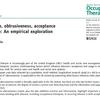Publications
Telecare, obtrusiveness, acceptance and use: An empirical exploration
Category: Journal Articles
People:

Hamblin, K. (2016) Telecare, obtrusiveness, acceptance and use: An empirical exploration. British Journal of Occupational Therapy, 1–7. DOI: 10.1177/0308022616667751.
Introduction: Telecare is increasingly part of the United Kingdom (UK)’s health and social care arrangements, and therefore occupational therapists’ practice. Understanding factors which influence telecare’s acceptance and usage is important to ensure optimal outcomes, both for service users and health and social care systems.
Method: This paper uses data collected by a qualitative, multi-method, longitudinal research study (n¼60) to explore whether an American model of ‘obtrusiveness’ is applicable to the UK context by examining what factors influence older adults’ acceptance and use of telecare.
Findings: The obtrusiveness model is broadly applicable to the UK context, but there are also two further issues which affected the acceptance and use of telecare: the degree of control a service user feels they have and the information and support they receive in using their devices.
Conclusion: The obtrusiveness model, plus the two additions (control and information), highlight important issues which could assist professionals working with telecare, including occupational therapists, in ensuring telecare is both accepted and well used.
- Population Horizons - Special Issues & Working Papers
- Population Horizons Archive (2015-2018)
- Blog
- IARU Newsletter
- Journal of Population Ageing
- Population Horizons Publications
- Books
- Book Chapters
- Journal Articles
- Research Reports & Policy Briefs
- Institute Working Papers
- Papers by members of the Institute's Regional Networks
- Visitors Papers
- Global Ageing Survey Research Reports
- Ageing Horizons
- Presentations & Posters
- Factsheets

